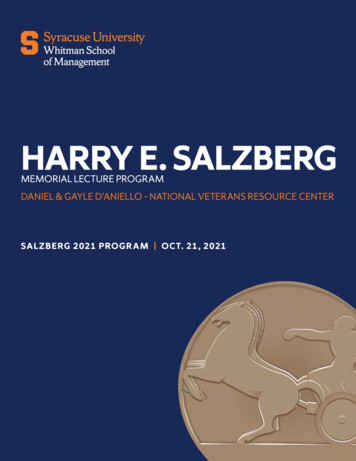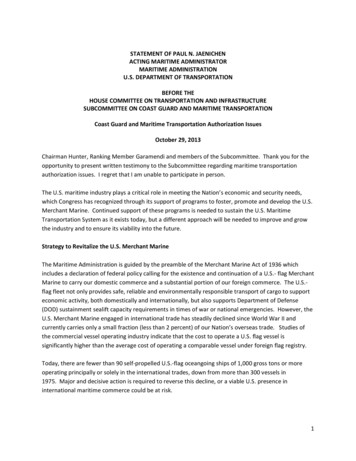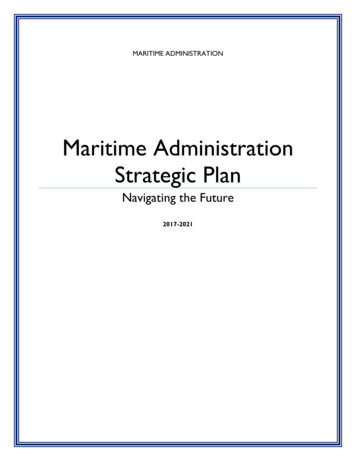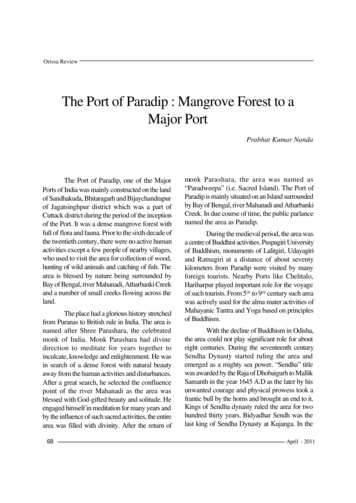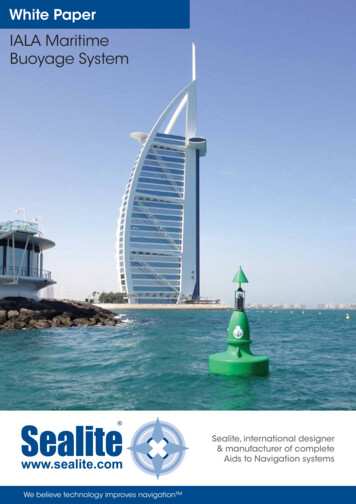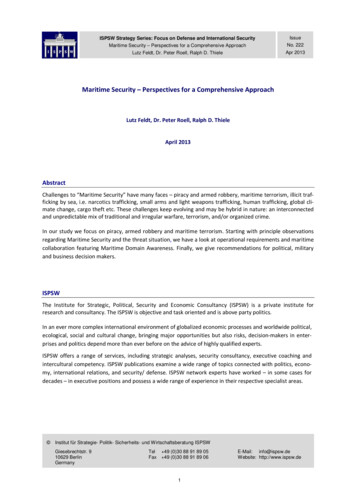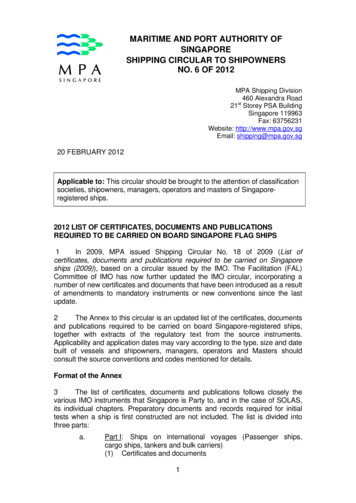
Transcription
MARITIME AND PORT AUTHORITY OFSINGAPORESHIPPING CIRCULAR TO SHIPOWNERSNO. 6 OF 2012MPA Shipping Division460 Alexandra Roadst21 Storey PSA BuildingSingapore 119963Fax: 63756231Website: http://www.mpa.gov.sgEmail: shipping@mpa.gov.sg20 FEBRUARY 2012Applicable to: This circular should be brought to the attention of classificationsocieties, shipowners, managers, operators and masters of Singaporeregistered ships.2012 LIST OF CERTIFICATES, DOCUMENTS AND PUBLICATIONSREQUIRED TO BE CARRIED ON BOARD SINGAPORE FLAG SHIPS1In 2009, MPA issued Shipping Circular No. 18 of 2009 (List ofcertificates, documents and publications required to be carried on Singaporeships (2009)), based on a circular issued by the IMO. The Facilitation (FAL)Committee of IMO has now further updated the IMO circular, incorporating anumber of new certificates and documents that have been introduced as a resultof amendments to mandatory instruments or new conventions since the lastupdate.2The Annex to this circular is an updated list of the certificates, documentsand publications required to be carried on board Singapore-registered ships,together with extracts of the regulatory text from the source instruments.Applicability and application dates may vary according to the type, size and datebuilt of vessels and shipowners, managers, operators and Masters shouldconsult the source conventions and codes mentioned for details.Format of the Annex3The list of certificates, documents and publications follows closely thevarious IMO instruments that Singapore is Party to, and in the case of SOLAS,its individual chapters. Preparatory documents and records required for initialtests when a ship is first constructed are not included. The list is divided intothree parts:a.Part I: Ships on international voyages (Passenger ships,cargo ships, tankers and bulk carriers)(1) Certificates and documents1
(2)Publicationsb.Part II: Other types of vessels on international voyages (HSC,WIG, SPS, OSV, MODU)(1) Certificates and documents(2) Recommended Publicationsc.Part III: Non-convention ships and Special Limits Passengerships(1) Certificates(2) DocumentsDigital Versions of Publications4With the increasing availability and convenience of use of digitalpublications, MPA has no objections to their use in lieu of the hard copy, whereindicated in the Annex to this circular. All publications on board ships, regardlessof format, should be the latest editions or duly corrected up to date. Please referto MSC-MEPC.2/Circ.2 IMO requirements on carriage of publications on boardships for more details. Masters are to ensure that the digital publications areeasily available for reference by ship officers and crew.5Computers used on board for digital publications should meet therequirements of MSC/Circ.891 Guidelines for the on-board use and applicationof computers.SOLAS Chapter V: Digital charts and publications6Please refer to Shipping Circular No. 3 of 2011 on the new SOLASrequirements for the carriage of ECDIS and digital nautical charts. AlthoughMPA allows for paperless operation with dual ECDIS, it should be noted thatraster charts do not have the full functionality of ECDIS and can only be usedwith an appropriate folio of up-to-date paper charts (see SN/Circ.207, Rev 1).7As the ECDIS regulation does not include digital nautical publications,such as Tide Tables and List of Lights, shipowners shall continue to seek MPA’sapproval for equivalence, as detailed in Shipping Circular No. 29 of 2006.Publications for Emergency use8Publications essential for emergency use shall always be available onboard in the form of hard copy, even if the vessel carries the digital versions,bearing in mind that such publications need to be readily available for use incase of emergency without being restricted to a specific place and by theavailability of a computer. These are, at least:a.b.International Code of Signals (SOLAS V/21.1); andIAMSAR Manual Volume III (SOLAS V/21.2),and any other publication or document deemed crucial for emergency use bythe company and vessel.2
Radio Regulations9The certificates and documents required to be carried on board comeunder the purview of the International Telecommunications Union (ITU). The listcontained in this circular is updated with the modification to Appendix 16(Documents with which stations on board ships and aircraft shall be provided) ofthe Radio Regulations (RR) (2008 edition) by the World RadiocommunicationsConference, 2007 (WRC-07) 1. International Morse Code Communications havedrawn to an end and therefore the regulations pertaining to Morse code havebeen deleted in the RR.10The modification to Appendix 16 also allows for the carriage in digitalformat of the more voluminous publications, namely:a.b.c.List of Ship Stations and Maritime Mobile Service IdentityAssignments;List of Coast Stations and Special Service Stations; andManual for Use by the Maritime Mobile and Maritime MobileSatellite Services.11It should be noted that the sole purpose of the “Manual for Use by theMaritime Mobile and Maritime Mobile-Satellite Services” has been to provide theshipping community with a compilation of treaty and regulatory and other ITUtexts relevant to the maritime mobile and maritime mobile-satellite services, andis not aimed at being a “manual” describing the GMDSS and/or other maritimeoperational procedures. This is to be found in another publication, publishedseparately by the IMO (“GMDSS Manual”, latest edition Sep 2011), and is alsoavailable in digital format.Shipping circulars12MPA encourages the shipping community to maintain the shippingcirculars on board in digital format. There is no need to retain a paper copy, aslong as shipowners ensure that the digital shipping circulars are easilyaccessible by ship officers and crew. MPA has been issuing circulars in PDFformat, for ease of downloading from MPA’s website and distribution to thecompanies and ships.Endorsement of Documents13The conventions require the carriage of certain records and documentsrelating to the regulations, for example, oil record book and garbagemanagement plan. These are usually published generically by commercialpublishers in the format given in the conventions. Shipowners seeking for theseto be endorsed and stamped by MPA should instead approach our ROs directlyfor the endorsement and stamp on MPA’s behalf. To date, MPA has notapproved those publications that are legal documents and records under theconventions or national legislation to be kept in digital format.1This was reported by the COMSAR subcommittee (COMSAR 12/4).3
Maritime Labour Convention (MLC)14Singapore acceded to the MLC in 2011 and the list of MLC-relatedcertificates, documents and records contained in the Annex to this circular is apreliminary list for the shipping community’s advance preparation. The carriageof MLC-related certificates, documents and records will become mandatoryupon entry into force of the convention. A further shipping circular will be issuedin due course providing information on the convention requirements that arespecific to Singapore.Purchase of National Legislation Publications15MPA does not stock or sell the maritime legislation publications ofSingapore. These may be purchased from:Toppan Leefung Pte LtdLegal PublicationGreat World CityEast Tower, #18-01/061, Kim Seng PromenadeSingapore 237994Tel: 6826 9691Fax: 6820 3341e-mail: legalpub@toppanleefung.comwebsite: www.toppanleefung.com/webshopMon–Fri: 9.30am–6pmSat, Sun and Public Holidays: Closed.16This circular updates and supersedes Shipping Circular No. 18 of 2009(List of certificates, documents and publications required to be carried onSingapore ships (2009)).17Any queries relating to this circular should be directed to Mr Ong HuaSiong (Tel: 6375 6210; email: shipping@mpa.gov.sg).CHEONG KENG SOONDIRECTOR OF MARINEMARITIME AND PORT AUTHORITY OF SINGAPORE4
ANNEX2012CERTIFICATES, DOCUMENTS AND PUBLICATIONSREQUIRED TO BE CARRIED ON BOARDDIFFERENT TYPES OF SINGAPORE SHIPS(Note: All certificates to be carried on board must be originals)PART I: SHIPS ON INTERNATIONAL VOYAGES(PASSENGER SHIPS, CARGO SHIPS, TANKERS, BULK CARRIERS)1.CERTIFICATES AND DOCUMENTSA. Merchant Shipping Act (CAP. 179) – Registryi. Certificate of RegistryOn completion of the registry of a ship, the Registrar shall grant a Certificate of Registrywhich shall state the particulars entered in the register.(Merchant Shipping Act, Section 16(1))Every State shall issue to ships to which it has granted the right to fly its Flag documentsto that effect.(UNCLOS article 91.2)B. Merchant Shipping (Official Log Books) Regulationsi. Official Log BookUnless otherwise stated, an official log book shall be kept in every ship.(Merchant Shipping (Official Log Books) Regulations, regulation 3(1))C. Merchant Shipping (Tonnage) Regulations (TONNAGE 69)i. International Tonnage Certificate (for ships of 24 m in length and above)An International Tonnage Certificate (1969) shall be issued to every ship, the gross andnet tonnage of which have been determined in accordance with the International TonnageConvention, 1969.(Tonnage Convention, article 7)ii. Singapore Tonnage Certificate (for ships of less than 24 m in length registered on orafter 6 Sep 85)A Singapore Tonnage Certificate shall be issued to every ship less than 24 metres inlength, the gross and net tonnages of which have been determined in accordance withPart II of the Merchant Shipping (Tonnage) Regulations.(Merchant Shipping (Tonnage) Regulations, regulation 7(1)(b))1
D. Merchant Shipping (Load Line) Regulations (1988 LOAD LINE PROTOCOL)i. International Load Line CertificateAn International Load Line Certificate shall be issued under the provisions of theInternational Convention on Load Lines, 1966, as modified by the 1988 LL Protocol forships of 24 metres in length and above.(Load Line 88 Protocol, article 18)ii. Singapore Load Line CertificateA Singapore Load Line Certificate shall be issued to every new ship of less than 24metres in length or every existing ship of less than 150 tons gross tonnage which hasbeen surveyed and marked in accordance with the Merchant Shipping (Load Lines)Regulations.(Merchant Shipping (Load Lines) Regulations, regulation 16(2))iii. International Load Line Exemption Certificate or Singapore Load LineExemption Certificate, as appropriate (when an exemption has been granted)An International Load Line Exemption Certificate, or Singapore Load Line ExemptionCertificate shall be issued to any to which an exemption has been granted under and inaccordance with the provisions of the International Convention on Load Lines, 1966, asmodified by the 1988 LL Protocol or the Merchant Shipping (Load Lines) Regulations,as appropriate.(Load Line Protocol, article 18; Merchant Shipping (Load Lines) Regulations, regulation16(3))iv. Approved Loading and Ballasting InformationThe master of every new ship shall be supplied with information to arrange for theloading and ballasting of his ship in such a way as to avoid the creation of anyunacceptable stresses in the ship’s structure, provided that this requirement need notapply to any particular length, design or class of ship where the Administration considersit to be unnecessary. Information shall be provided to the master in a form that isapproved by the Administration or a recognized organization.(1988 Load Line Protocol, regulation 10)see also “Ballast Water Management Plan”E. Merchant Shipping (Prevention of Collisions at Sea) Regulations (COLREG 72)i. Dispensation Certificate from the technical requirements of the InternationalRegulations for Preventing Collisions at Sea, 1972 (COLREG) (when a dispensationhas been granted)A dispensation certificate shall be issued when it has been determined that a vessel ofspecial construction or purpose cannot comply fully with the provisions of any of theseRules.(COLREG Rule 1(e))ii. Certificates of Approval/Plans and Specification for Navigational LightsThe lights and shapes specified in these Rules shall comply with the provisions of AnnexI to these Regulations.(COLREG Rule 20)2
The construction of lanterns and shapes and the installation of lanterns on board thevessel shall be to the satisfaction of the appropriate authority of the State whose flag thevessel is entitled to fly.(COLREG Annex I/14)F. Merchant Shipping (Safety Convention) Regulations (SOLAS 74) – Certificatesi. Passenger Ship Safety Certificate (supplemented by its Record of Equipment)A certificate called a Passenger Ship Safety Certificate shall be issued after inspectionand survey of a passenger ship which complies with the requirements of chapters II-1, II2, III and IV and any other relevant requirements of SOLAS 1974. A Record ofEquipment for the Passenger Ship Safety Certificate (Form P) shall be permanentlyattached.(SOLAS 1974, regulation I/12, appendix)Application: Passenger shipsii. Cargo Ship Safety Construction Certificate (for ships of 500 GT and above)A certificate called a Cargo Ship Safety Construction Certificate shall be issued aftersurvey to a cargo ship of 500 gross tonnage and over which satisfies the requirements forcargo ships on survey, set out in regulation I/10 of SOLAS 1974, and complies with theapplicable requirements of chapters II-1 and II-2, other than those relating to fireextinguishing appliances and fire control plans.(SOLAS 1974, regulation I/12, appendix)Application: Cargo shipsiii. Cargo Ship Safety Equipment Certificate (for ships of 500 GT and above and thecertificate to be supplemented by its Record of Equipment)A certificate called a Cargo Ship Safety Equipment Certificate shall be issued aftersurvey to a cargo ship of 500 gross tonnage and over which complies with the relevantrequirements of chapters II-1 and II-2 and III and any other relevant requirements ofSOLAS 1974. A Record of Equipment for the Cargo Ship Safety Equipment Certificate(Form E) shall be permanently attached to the Certificate.(SOLAS 1974, regulation I/12, appendix)Application: Cargo shipsiv. Cargo Ship Safety Radio Certificate (for ships of 300 GT and above and thecertificate to be supplemented by its Record of Equipment)A certificate called a Cargo Ship Safety Radio Certificate shall be issued after survey tocargo ship of 300 gross tonnage and over, fitted with a radio installation, including thoseused in life-saving appliances which complies with the requirements of chapters III andIV and any other relevant requirements of SOLAS 1974. A Record of Equipment for theCargo Ship Safety Radio Certificate (Form R) shall be permanently attached to theCertificate.(SOLAS 1974, regulation I/12, appendix)Application: Cargo ships[Cargo Ship Safety Certificate, as an alternative to Cargo Ship Safety Construction,Equipment and Radio certificates aboveA certificate called a Cargo Ship Safety Certificate may be issued after survey to a cargoship which complies with the relevant requirements of chapters II-1, II-2, III, IV and V3
and other relevant requirements of SOLAS 1974 as modified by the 1988 SOLASProtocol, as an alternative to the above cargo ship safety certificates.(1988 SOLAS Protocol, regulation I/12(a)(v), appendix)]NOTE: Although the SOLAS 1988 Protocol has provision for a single safety certificate,Singapore does not exercise this option nor issue such a certificate.(SOLAS regulation I/12(a)(v) has not been transposed into the Merchant Shipping(Safety Convention) Regulations)]v. Exemption Certificate or Letter of Dispensation (when an exemption dispensationhas been granted under the provisions of SOLAS 74 as amended)When an exemption is granted to a ship under and in accordance with the provisions ofSOLAS 1974, a certificate called an Exemption Certificate shall be issued in addition tothe certificates listed above.(SOLAS 1974, regulation I/12)G. Merchant Shipping (Safety Convention) Regulations (SOLAS 74) – Structure,Subdivision and Stability/2008 IS Codei. Certificates of Class, accompanied by, as appropriate:a.Drawings, Plans and Instruction manuals, including Oxygen Analysis andGas Detection Equipment, as appropriate, necessary for the safe operation ofthe ship concerned (see also SOLAS 1974, regulation II-1/3-7)b.Reports and Records of Periodical Surveys of Hull, Machinery, Boilers andSafety Valves and EquipmentIn addition to the requirements contained elsewhere in the present regulations, ships shallbe designed, constructed and maintained in compliance with the structural, mechanicaland electrical requirements of a classification society which is recognized by theAdministration in accordance with the provisions of regulation XI-1/1, or with applicablenational standards of the Administration which provide an equivalent level of safety.(SOLAS 1974, regulation II-1/3-1)ii. Evidence of seaworthinessThe following documents may be accepted by the Registrar as evidence that a ship is in aseaworthy condition for registry under section 12 or 13 of the Act: (a) a classificationcertificate issued by a classification society which has been authorized to issuecertificates on behalf of the Government; and (b) such other documents relating to theseaworthiness of the ship as the Registrar may determine.(Merchant Shipping (Registration of ships) Regulations, regulation 14(1))Application: new registration.iii. Intact Stability BookletEvery passenger ship regardless of size and every cargo ship having a length (L) of 24 mand upwards, shall be inclined upon its completion and the elements of its stabilitydetermined. In addition to any other applicable requirements of the present regulations,ships having a length of 24 m and upwards constructed on or after 1 July 2010 shall as aminimum comply with the requirements of part A of the 2008 IS Code.(SOLAS 1974, regulation II-1/5.1)Each ship shall be provided with a stability booklet, approved by the Administration,which contains sufficient information (see part B, 3.6) to enable the master to operate theship in compliance with the applicable requirements contained in the Code. If a stability4
instrument is used as a supplement to the stability booklet for the purpose of determiningcompliance with the relevant stability criteria such instrument shall be subject to theapproval by the Administration.(International Code on Intact Stability, 2008 (2008 IS Code), paragraph 2.1.6)iv. Stability Instrument Approved test conditions and Operation Manual (ApprovalProcedure)The satisfactory operation of the stability instrument is to be verified by testing uponinstallation (refer to 4.1.8). A copy of the approved test conditions and the operationmanual for the stability instrument are to be available on board.(International Code on Intact Stability, 2008 (2008 IS Code), paragraph 4.1.6)v. Stability Instrument test condition results (Periodical testing)It is the responsibility of the ship’s master to check the accuracy of the stabilityinstrument at each annual survey by applying at least one approved test condition. If anAdministration’s representative is not present for the stability instrument check, a copy ofthe test condition results obtained by this check should be retained on board asdocumentation of satisfactory testing for the Administration’s representative’sverification.(International Code on Intact Stability, 2008 (2008 IS Code), paragraph 4.1.9.1)vi. Stability information to be supplied to the masterThe master shall be supplied with such information satisfactory to the Administration asis necessary to enable him by rapid and simple processes to obtain accurate guidance asto the stability of the ship under varying conditions of service. A copy of the stabilityinformation shall be furnished to the Administration.(SOLAS 1974, regulation II-1/5-1)Referring to SOLAS chapter II-1, regulation 19, the necessity to provide the crew withthe relevant information regarding the subdivision of the ship is expressed, thereforeplans should be provided and permanently exhibited for the guidance of the officer incharge. These plans should clearly show for each deck and hold the boundaries of thewatertight compartments, the openings therein with means of closure and position of anycontrols thereof, and the arrangements for the correction of any list due to flooding. Inaddition, Damage Control Booklets containing the aforementioned information should beavailable.(Explanatory Notes to SOLAS chapter II-1, paragraph 1.2.3)vii. Damage Control Plans and BookletThere shall be permanently exhibited, or readily available on the navigation bridge, forthe guidance of the officer in charge of the ship, plans showing clearly for each deck andhold the boundaries of the watertight compartments, the openings therein with the meansof closure and position of any controls thereof, and the arrangements for the correction ofany list due to flooding. In addition, booklets containing the aforementioned informationshall be made available to the officers of the ship.(SOLAS 1974, regulations II-1/19.1)viii. Damage Stability informationIn case of ships to which damage stability requirements of part B-1 apply, damagestability information shall provide the master a simple and easily understandable way ofassessing the ship’s survivability in all damage cases involving a compartment or groupof compartments.(SOLAS 1974, regulations II-1/19.5)5
ix. Records of closure of doors at seaThe closure of cargo loading doors and the opening and closing of any doors at searequired for the operation of the ship or the embarking and disembarking of passengersshall be recorded in the logbook.(SOLAS 1974, regulation II-1/22)x. Manoeuvring InformationThe ability of the machinery to reverse the direction of thrust of the propeller in sufficienttime, and so to bring the ship to rest within a reasonable distance from maximum aheadservice speed, shall be demonstrated and recorded. The stopping times, ship headings anddistances recorded on trials, together with the results of trials to determine the ability ofships having multiple propellers to navigate and manoeuvre with one or more propellersinoperative, shall be available on board for the use of the master or designated personnel.(SOLAS 1974, regulation II-1/28)xi. Emergency towing procedures on shipsShips shall be provided with a ship-specific emergency towing procedure. Such aprocedure shall be carried aboard the ship for use in emergency situations and shall bebased on existing arrangements and equipment available on board the ship.(SOLAS regulation II-1/3-4, paragraph 2)xii. Emergency towing bookletThe Emergency Towing Booklet (ETB) should be ship specific and be presented in aclear, concise and ready-to-use format. A copy should be kept at hand by theowners/operators in order to facilitate the passing on of information to the towagecompany as early as possible in the emergency. A copy should also be kept in a commonelectronic file format, which will allow faster distribution to the concerned parties. Aminimum of three copies should be kept on board and located in: 1. the bridge; 2. aforecastle space; and 3. the ship’s office or cargo control room.(MSC.1/Circ.1255 – Guidelines for Owners/Operators on preparing Emergency TowingProcedures, paragraph 4)xiii. Towing and Mooring Arrangements PlanShips shall be provided with arrangements, equipment and fittings of sufficient safeworking load to enable the safe conduct of all towing and mooring operations associatedwith the normal operation of the ship. The SWL for the intended use for each shipboardfitting should be noted in the towing and mooring arrangements plan available on boardfor the guidance of the Master.(SOLAS 1974, regulation II-1/3-8; MSC/Circ.1175 – Guidance on Shipboard Towingand Mooring Equipment, paragraph 5)xiv. Documentary Evidence of Fitness of Ship to Operate with PeriodicallyUnattended Machinery SpacesEvery ship shall be provided with documentary evidence, to the satisfaction of theadministration, of its fitness to operate with periodically unattended machinery spaces.(SOLAS 1974, regulation II-1/46.3)xv. Ship Structure Access ManualA ship’s means of access to carry out overall and close-up inspections and thicknessmeasurements shall be described in a Ship structure access manual approved by theAdministration, an updated copy of which shall be kept on board.(SOLAS 1974, regulation II-1/3-6)6
Application: Oil tankers and bulk carriersxvi. Construction drawings to be maintained on board and ashoreA set of as-built construction drawings and other plans showing any subsequentstructural alterations shall be kept on board a ship constructed on or after 1 January 2007.An additional set of such drawings shall be kept ashore by the Company, as defined inregulation IX/1.2.1 Main plans –.1General arrangement;.2Capacity plan;.3Hydrostatic curves; and.4Loading Manual, where required.2 Steel plans –.1Midship section;.2Scantling plan;.3Decks;.4Shell expansion;.5Transverse bulkheads;.6Rudder and rudder stock; and.7Cargo hatch covers, where applicable.3 Bilge, ballast and cargo piping diagrams.(SOLAS 1974, regulation II-1/3-7; MSC/Circ.1135 – As-built construction drawings tobe maintained on board the ship and ashore)xvii. Special requirements for ro-ro passenger shipsDocumented operating procedures for closing and securing all shell doors, loading doorsand other closing appliances which, if left open or not properly secured, could, in theopinion of the Administration, lead to flooding of a special category space or ro-ro space,shall be kept on board and posted at an appropriate place.(SOLAS 1974, regulation II-1/23)Application: Ro-ro passenger shipsxviii. Coating Technical File (CTF) (Seawater ballast tanks)All dedicated seawater ballast tanks arranged in ships and double-side skin spacesarranged in bulk carriers of 150 m in length and upwards shall be coated duringconstruction in accordance with the “Performance standard for protective coatings fordedicated seawater ballast tanks in all types of ships and double-side skin spaces of bulkcarriers”, adopted by the Maritime Safety Committee by resolution MSC.215(82), as maybe amended by the Organization.The Coating Technical File shall be kept on board and maintained throughout the life ofthe ship.(SOLAS 1974 regulation II-1/3-2; resolution MSC.215(82) – Performance Standard forProtective Coatings for Dedicated Seawater Ballast Tanks in all types of Ships andDouble-Side Skin Spaces of Bulk Carriers, paragraph 3.4)Application: All ships and double-side skin of bulk carriersxix. Coating Technical File (Crude Oil Tankers)The Coating Technical File shall be kept on board and maintained throughout the life ofthe ship.(Performance Standard for Protective Coatings for Cargo Oil Tanks of Crude OilTankers, MSC.288(87), paragraph 3.4.4)Application: Crude oil tankers7
xx. Technical File (Crude Oil Tankers – alternate means of protection)The Technical File shall be kept on board and maintained throughout the life of the ship.(Performance Standard for Alternative Means of Corrosion Protection for Cargo OilTanks of Crude Oil Tankers, MSC.289(87), paragraph 2.2.2)Application: Crude oil tankersxxi. Coating Technical file (Void spaces)Specification of the coating system applied to void spaces in bulk carriers and oil tankers,records of the shipyard’s and shipowner’s coating work, detailed criteria for coatingselection, job specifications, inspection, maintenance and repair should be documented inthe Coating Technical File (CTF), which should be reviewed by the Administration or anorganization recognized by the Administration.The Coating Technical File should be kept on board and maintained throughout the lifeof the ship.(Resolution MSC.244(83) – Performance Standard for Protective Coatings for VoidSpaces on Bulk Carriers and Oil Tankers, Section 3.4.5)Application: Bulk carriers and oil tankersxxii. Ship Construction File (Goal-based Standards)A Ship Construction File with specific information on how the functional requirementsof the Goal-based Ship Construction Standards for Bulk Carriers and Oil Tankers havebeen applied in the ship design and construction shall be provided upon delivery of a newship, and kept on board the ship and/or ashore and updated as appropriate throughout theship’s service. The contents of the Ship Construction File shall, at least, conform to theguidelines developed by the Organization.(SOLAS 1974, regulation II-1/3-10.4)Application: Bulk carriers and oil tankersApplication dates, see MSC.290(87)PERFORMANCE STANDARDS FOR WATER LEVEL DETECTORS(MSC.188(79))Application: Bulk carriers and Single hold cargo shipsi. Test recordsEach detector alarm should be tested to verify that the pre-alarm and main alarm levelsoperate for every space where they are installed and indicate correctly. Also, the faultmonitoring arrangements should be tested as far as practicable.Records of testing of alarm systems should be retained on board.(MSC.188(79), Section 3.3)ii. ManualsDocumented operating and maintenance procedures for the water level detection systemshould be kept on board and be readily accessible.(MSC.188(79), Section 3.5)8
H. Merchant Shipping (Safety Convention) Regulations (SOLAS 74) – FireSafety/FSS Codei. Maintenance PlanThe maintenance plan shall include the necessary information about fire protectionsystems and fire-fighting systems and appliances as required under regulation II-2/14.2.2.For tankers, additional requirements are referred to in regulation II-2/14.4.(SOLAS 1974, regulations II-2/14.2.2 and II-2/14.4 )ii. Fire safety training manualA training manual shall be written in the working language of the ship and shall beprovided in each crew mess room and recreation room or in each crew cabin. The manualshall contain the instructions and information required in regulation II-2/15.2.3.4. Part ofsuch information may be provided in the form of audio-visual aids in lieu of the manual.(SOLAS 1974, regulation II-2/15.2.3)iii. Fire Control plan/booklet, and also Duplicates of Plans or Booklets on either si
Maritime Mobile and Maritime MobileSatellite Services" has been to provide the - shipping community with a compilation of treaty and regulatory and other ITU texts relevant to the maritime mobile and maritime mobile-satellite services, and is not aimed at being a "manual" describing the GMDSS and/or other maritime operational procedures.
